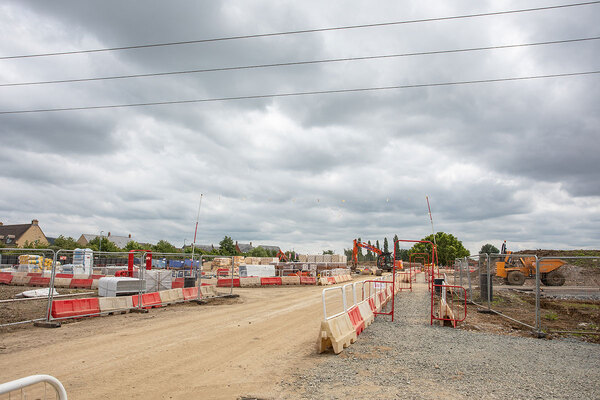What do the latest fuel poverty stats tell us?
In the third Housing Fuel Poverty Index update of 2024, Inside Housing looks at the numbers reported by Switchee’s smart thermostats to help track fuel poverty across the UK
In association with:
![]()
The latest data from smart thermostat provider Switchee suggests that fuel poverty is easing slightly across the UK’s social housing stock, as energy prices continue to fall.
For the third consecutive quarter, Switchee’s Housing Fuel Poverty Index, which uses its smart devices to track fuel poverty in real time, shows that the proportion of social rented homes that failed to reach 18°C in any of the previous seven days was down compared to the same period the previous year.
From 1 March to 31 May this year, the percentage of homes failing to reach the temperature stood at just 5.2% across all UK regions. This compares with 7.9% of homes that were in fuel poverty according to this metric across the same dates in 2023. This means that just over one in 20 homes in the social rented sector were in fuel poverty during the spring of this year, compared to around one in 12 last spring.
Indeed, as more data is accrued from Switchee’s smart thermostats, a fuller picture of fuel poverty across the year has built up. It now shows that for the nine months where a direct comparison is available (1 September to 31 May), the average proportion of homes not reaching 18°C in any of the previous seven days was just 5.8% in 2023-24 compared to 7.9% in 2022-23.
“The year-on-year improvement underscores the impact of falling energy prices, and efforts by providers to carry out retrofit improvements and direct interventions, although it has been skewed by a milder winter. It should also be noted that fuel poverty remains 25% higher than in the winter of 2021-22, indicating that there is still much work to be done to support vulnerable households,” says Ben Morris, data lead at Switchee.
In terms of the role that the relatively mild winter and warm early spring have played, to take a single month as an example, the average UK temperature in March this year was 6.7°C, 1°C above the same month in 2023.
Furthermore, the Switchee data is not reflected in the UK government’s latest statistics from February, which show that fuel poverty virtually unchanged year on year. However, the Switchee data is more up to date and could be said to give a better real-time indication of fuel poverty levels.
Sharp drops in Wales and NI
In Northern Ireland, the year’s second quarter saw a sharp decline in fuel poverty, with just 4.2% of homes on average failing to record 18°C over any seven-day period. That compares to 14.8% in spring 2023.
Wales saw a similar drop-off, with the average proportion of homes in fuel poverty falling from 12.4% to just 5.6%. In Scotland, meanwhile, the change was more in line with the UK average, with 5.8% of homes failing to record 18°C over seven days on average in March to May this year, compared with 7.8% in 2023.
Looking at individual regions, social homes in the West Midlands and South West of England experienced the most fuel poverty in the three months to the end of May, according to Switchee.
In the South West, an average of 7.4% of homes failed to achieve 18°C in any seven-day period, while that figure was 6.7% in the West Midlands.
5.2%
Social homes that failed to reach 18°C over seven consecutive days from March to May 2024 (compared with 7.9% last year)
4.2%
Social homes in Northern Ireland in fuel poverty by the same metric (compared with 14.8% in spring 2023)
These results are nevertheless a significant improvement on the same period in 2023, when an average 12.3% of social homes in the South West failed to reach the threshold on any given day, while in the West Midlands, the proportion was 10.6%.
Improving picture in the North East
Having been the worst-performing English region in the previous two quarters, the North East of England experienced only the fourth-most fuel poverty this spring, with 5.6% of social homes not reaching the 18°C threshold over seven days.
The North West, meanwhile, saw an average of 6.0% of its homes fail to reach that mark during the same period.
At the other end of the spectrum, in Greater London, just 3.5% of social homes on average failed to reach the 18°C mark over seven days between March and May. Next best was the East of England, with a figure of 4.2%, while in Yorkshire and the Humber, only 4.3% of homes on average were deemed to be in fuel poverty.
In the East Midlands, one in 20 homes (5.0%) experienced fuel poverty on average in spring 2024, while the South East of England most closely matched the national average, with a figure of 5.2%.
Recent content in association with Switchee
CPD webinar on demand: fostering data-driven engagement with residents on fuel poverty
As part of Inside Housing’s CPD offering, watch the full webinar and earn CPD minutes
How can social landlords use data to tackle fuel poverty?
As we enter winter and fuel bills spike, half of social tenants cannot afford to heat their homes, but identifying who those tenants are remains a challenge. Here, sector leaders discuss how better use of data could fight energy poverty
UK fuel poverty: a cool summer affects results
In the fourth Housing Fuel Poverty Index update of 2024, Inside Housing looks at the numbers reported by Switchee’s smart thermostats to help track fuel poverty across the UK
CPD webinar on demand: how can social landlords assess whether retrofit is delivering intended performance improvements?
As part of Inside Housing’s CPD offering, watch the full webinar and earn CPD minutes
What do the latest fuel poverty stats tell us?
In the third Housing Fuel Poverty Index update of 2024, Inside Housing looks at the numbers reported by Switchee’s smart thermostats to help track fuel poverty across the UK
CPD module: how to approach decarbonisation policy and strategies
The policy environment on decarbonisation and retrofit is evolving, so how can social landlords continue to build strategies to meet net zero? Richard Ellis, director of sustainability at Peabody, explains in this CPD module
What will Awaab’s Law mean for landlords and residents?
An Inside Housing roundtable, in association with Switchee, discusses how incoming legislation will affect how landlords approach repairs and maintenance in their homes
Using data to deliver better services
How are landlords collecting data and using it to make decisions about asset management and meeting residents’ needs? An Inside Housing survey, with data analytics firm Switchee, finds out
Is fuel poverty on the decline?
The latest data from smart thermostat provider Switchee suggests that the fuel poverty crisis may be starting to ease. Inside Housing analyses the figures
The numbers behind fuel poverty in the UK
Switchee’s new model shows the number of social households underheating their homes across the UK in real time, during 2022 and 2023. Inside Housing looks into the figures
How can landlords help residents to save on energy bills?
Inside Housing speaks to Emma Bitting at Switchee to find out what residents can do to ensure their homes are warm, and how they can save money on bills
How landlords are using data to tackle fuel poverty
An Inside Housing roundtable, in association with Switchee, discusses how landlords can analyse data to ensure they are helping residents who are struggling with energy costs
Internet of Things devices start to make a difference
A national network of vetted installers means the industry can collaborate to provide landlords with invaluable insights, says Philip Taylor of Internet of Things device provider Switchee
Choosing smart data and tech can help landlords achieve Better Social Housing Review goals
Technology can help landlords in terms of their business and regulatory compliance, as well as improving residents’ quality of life and bringing down bills, explains Tom Robins of tech firm Switchee
Sign up for our asset management newsletter
Already have an account? Click here to manage your newsletters












